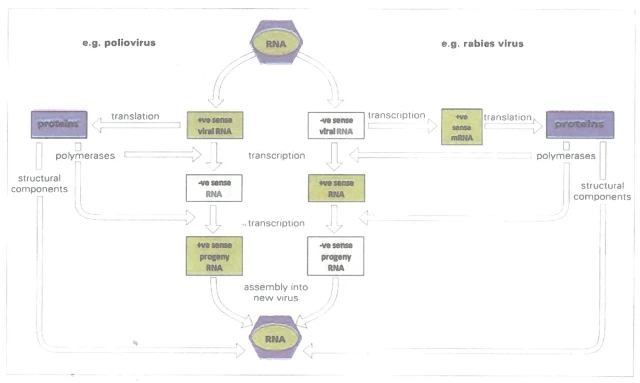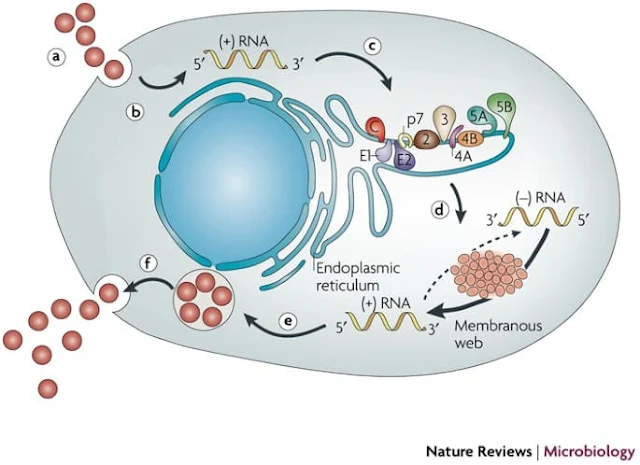Viruses are unable to replicate on their own because they lack the genes and enzymes necessary for energy production. Therefore, replication depends on living host cells and is directed by the viral genome to produce the virus components.
Viral replication occurs in the following steps (Fig. 1).
 |
| Fig. 1: Steps of viral replication |
The stages of a Virus's Life Cycle
1. Attachment or adsorption: The virus attaches to specific receptor sites on the surface of the susceptible host cell. These interactions determine viral host range (e.g., human viruses and plant viruses) and tissue specificity or tropism (e.g. hepatotropic viruses and neurotropic viruses).
2. Penetration: The viruses may enter the host cells by either:
- Endocytosis: In the case of non-enveloped viruses.
- Fusion of viral envelope with host cell membrane: In the case of enveloped viruses.
3. Uncoating: The nucleic acid is released from the capsid by the action of cellular enzymes and becomes available for replication.
4. Synthesis of viral components
A) Synthesis of viral proteins
Transcription:Viruses must first synthesize virus-specific messenger RNA (mRNA) to synthesize virus specific proteins.
Transcription of mRNA varies according to the type of viral nucleic acid whether DNA or RNA, ds or ss, positive or negative sense strand, as follows:
a) DNA viruses: mRNA can be transcribed from the negative sense strand using the host's DNA-dependent RNA polymerase.
b) RNA viruses: There is no host cell RNA polymerase that can use the viral RNA as a template for synthesis of mRNA. RNA viruses fall into 4 groups according to the strategy for synthesizing mRNA (Fig. 2-A):
- In dsRNA viruses, the negative sense strand is transcribed by viral RNA- dependent RNA polymerase into mRNA.
- In ssRNA viruses, there are 3 distinct routes to the formation of mRNA:
- The strand with positive sense acts directly as mRNA.
- The strand with negative sense must first be transcribed, using viral RNA-dependent RNA polymerase, into positive sense strand which can then act as mRNA.
- A double-stranded RNA intermediate is formed during the replication process, and this intermediate serves as a template for the synthesis of mRNA by viral RNA-dependent RNA polymerase.
- In retroviruses, the positive ssRNA is first made into a negative sense ssDNA using the viral reverse transcriptase. Then dsDNA is formed by the host DNA-dependent DNA polymerase. This dsDNA enters the nucleus and is either:
 |
| Fig. 2-A: Transcription in RNA viruses |
- transcribed by host's DNA-dependent RNA polymerase into mRNA or
- integrated in host cell genome causing transformation.
B) Synthesis of viral nucleic acid:
 |
| Fig. 2-B: Replication of viral genome |
Assembly:
The newly synthesized protein coats enclose the replicated nucleic acids to form mature viruses (virions). This occurs either in the nucleus of the host cell, e.g. herpes viruses or in the cytoplasm, e.g. polioviruses.
N.B.:
- Lysis of host cell in case of non-enveloped viruses, e.g. poliovirus or
- Budding through the cell membrane in case of enveloped viruses, e.g. HIV.
